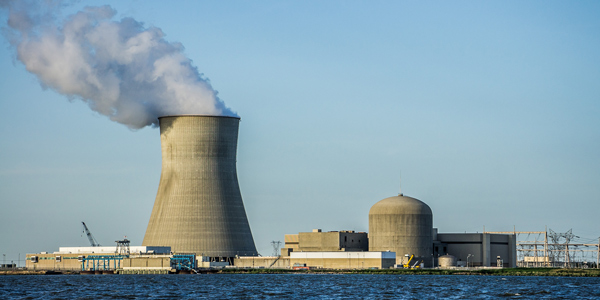Public Service Enterprise Group (PSEG) is putting its solar and fossil fuel generation on the block as it seeks to transform into a primarily regulated electric and gas utility, company officials announced Friday during its second quarter earnings call.
In his presentation, PSEG CEO Ralph Izzo said the company is “exploring strategic alternatives” for its non-nuclear-generating fleet, which includes more than 6,750 MW of fossil generation in New Jersey, Connecticut, New York and Maryland, and 467 MW of solar generation in 17 states.
“Our intent is to accelerate the transformation of PSEG into a primarily regulated electric and gas utility — a plan we have been executing successfully for more than a decade,” Izzo said in a statement.
Izzo noted that separating its non-nuclear assets would reduce PSEG’s business risks and earnings volatility and that it would continue to improve its credit profile by investing in clean energy, methane reduction and zero-carbon generation. He said work is underway to market a potential transaction beginning in the fourth quarter of 2020 with closing sometime in 2021.
Izzo said a “shift in investor preference” toward owning regulated utility businesses without commodity exposure to merchant generation and related earnings volatility has been gaining momentum in the energy sector.
“We’re excited to explore the opportunities that will shape PSEG’s future,” Izzo said. “It is a future focused on advancing our business as a sustainable customer-focused provider of essential electricity and natural gas service, delivered by a regulated utility and contracted businesses.”
PSEG Generation’s Future
PSEG intends to retain ownership of its existing nuclear fleet under its PSEG Power subsidiary, Izzo said. Its nuclear fleet includes the 2,285-MW Salem and 1,173-MW Hope Creek Nuclear plants in Lower Alloways Creek Township, N.J., and part ownership in the 2,549-MW Peach Bottom Nuclear plant in York County, Pa.
Izzo said the Salem and Hope Creek nuclear plants produce more than 90% of New Jersey’s zero-carbon electricity and are a “cost efficient necessary component” of the state’s transition to 100% clean energy by 2050, which was outlined in the New Jersey Energy Master Plan finalized in January.
The New Jersey plants receive zero-emission credit (ZEC) state subsidies, he said, which added $0.02 a share in earnings in the second quarter. ZEC applications for the next three-year period are due in the fall with a decision by the New Jersey Board of Public Utilities (BPU) expected in April 2021.
“As we begin the second round of the ZEC program by filing our applications this fall, it’s important to note that the financial need for ZECs is more critical than ever,” Izzo said.
PJM’s day-ahead power prices have remained in the mid-teens to low $20s per MWh most days during the second quarter, with recent temperatures in the mid-80s to mid-90s only causing prices to cross the $30/MWh threshold twice in the last 30 days in the PSEG zone.
Izzo said PJM day-ahead prices have declined from where they were just two years ago, when forward around-the-clock prices for the PSEG zone were approximately $30/MWh to just more than $25/MWh today. He said the lower prices reflect current market conditions, characterized by reduced loads, inexpensive natural gas and abundant generation.
“This market environment is the reality we face at our nuclear stations and is the driver behind ZECs,” Izzo said.
Besides its nuclear fleet, he said PSEG is continuing to evaluate potential investments in offshore wind, including a decision regarding the opportunity to acquire a 25% interest in Ørsted’s 1,100-MW Ocean Wind project later this year. (See Orsted Wins Record Offshore Wind Bid in NJ.)
The company is also evaluating participation in upcoming offshore wind solicitations in New Jersey and other Mid-Atlantic states. On July 21, New York opened a solicitation for up to 2,500 MW of offshore wind power generation capacity.
Earnings
Dan Cregg, PSEG’s executive vice president and CFO, announced a second-quarter profit of $451 million ($0.89/share), compared to $153 million ($0.30/share) last year.
Non-GAAP operating earnings were $404 million ($0.79/share), compared to $294 million($0.58/share) in 2019. The operating earnings beat the average estimate of five analysts surveyed by Zacks Investment Research of 59 cents per share.
PSEG expects full-year earnings in the range of $3.30 to $3.50/share.
Transmission Projects
Analysts on the earnings call asked about any transmission capital expenditures that could be on the horizon for PSEG.
Izzo said its subsidiary, Public Service Enterprise & Gas, continues to make progress on its portfolio of capital improvements, including several key transmission projects. In the second quarter, the company energized the second phase of its $739 million Metuchen-Trenton-Burlington Project and upgraded the transmission circuits between the Brunswick and Trenton stations.
The company also expects to complete work on a 6-mile upgrade of a 230-kV overhead transmission circuit running between the Aldene station and the Linden variable frequency transformer station by end of the 2020, having already completed approximately half of the project.
Most of the large transmission projects that came out of the PJM Regional Transmission Expansion Plan (RTEP) are “pretty much complete or near complete,” Izzo said. There is also the possibility of increasing transmission investment as New Jersey continues pursuing offshore wind.
“One of the things that the BPU is talking to all utilities, not just us, about is the possibility for accelerating some of the infrastructure programs that we want to do to help create some economic stimulus. And just given the age of our transmission infrastructure, and age of our gas infrastructure, that is something that could provide further opportunities for us as well,” Izzo said.





